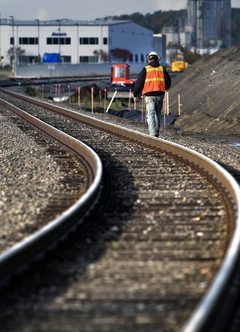forum
library
tutorial
contact

West Coast Ports Band Together
to Fight Global Competition
by Amy HsuanThe Oregonian, November 11, 2009
|
the film forum library tutorial contact |

|
West Coast Ports Band Together
by Amy Hsuan |
 In the big business of international trade, chasing shipping carriers and containers has long been a competitive sport among the world's ports, gateways for overseas goods reaching American consumers.
In the big business of international trade, chasing shipping carriers and containers has long been a competitive sport among the world's ports, gateways for overseas goods reaching American consumers.
But with a global recession flattening trade, West Coast ports are forming an unlikely alliance to fend off a wave of falling imports.
This week, at the World Shipping Summit in China, the Port of Portland will join forces for the first time with other major West Coast ports, including Long Beach, Los Angeles, Seattle, Tacoma and Oakland.
Along with Burlington Northern Santa Fe and Union Pacific railroads, the ports are hoping to shake off a challenge from those on the East Coast, Mexico and Canada.
The goal: to market the efficiencies, distribution networks and skilled labor forces of the West Coast ports in the face of rising competition.
"It is generally a recognition that the ports and railroads share many interests and cannot take anything for granted in a competitive and changing industry," said Josh Thomas, spokesman for the Port of Portland.
Over the past year, the global recession has tested the long-held dominance of the West Coast ports, which handle nearly 70 percent of the traffic coming from Asia, the nation's largest trading partner.
In Portland, ocean-going container traffic has fallen by as much 34 percent, with more than 37 percent fewer vessels arriving at its docks. Similar trends have rocked the ports of Los Angeles and Long Beach, the nation's two busiest ports, as well as others on the West Coast. On average, traffic has been down 15 to 20 percent.
It's a downward trend that could be exacerbated by the ongoing expansion of the Panama Canal, which will allow for larger Asian ships to sidestep West Coast ports and head directly to East Coast markets, said Walter Kemmsies, an economist with engineering firm Moffat & Nichol.
"Before, 7 to 9 years ago, your only options were the West Coast ports," Kemmsies said. "But now the East Coast ports have gotten pretty good."
Over the past couple of years, ports in the East Coast and Gulf Coast have been investing heavily in infrastructure and gaining a bigger piece of the trade pie. Railroads like Norfolk Southern on the East Coast have been laying miles of track to markets in the Midwest. In Houston and Savannah, Ga., loads of warehouse spaces have cropped up.
And while the recession has equally hurt eastern ports, the improvements have meant that shippers no longer rely solely on the West Coast to get their goods inland. In addition, congestion over the years at the Los Angeles and Long Beach ports have meant that shippers were already looking for alternative routes.
Over the past decade, West Coast ports have lost about 1 percent of traffic each year to ports elsewhere, including in Canada and Mexico.
"Over the last couple of years, you already saw a lot of shift of volume because of the compelling economics," Kemmsies said. "As the infrastructure in the country improves, you have to expect the routes to change a bit."
But the global recession has only elevated the anxiety of West Coast ports over the loss of business. Some industry insiders say the economic lull will stretch on for years, which means competition among ports will remain cut-throat.
"There won't be an uptick until 2011," said Barry Horowitz, a consultant for the Port of Portland. "It's painful, but 2010 will not be a hugely busy year for the shipping and port business."
In recent months, the six major West Coast ports and two railroads have met twice to find a way to work together.
At the shipping summit in China this week, they'll tout the cost advantages, as well as environmental benefits, of moving cargo through the West Coast. The ports have invested billions of dollars in maritime terminals, road and rail infrastructure and navigation improvements over the past decade.
In addition, the West Coast ports have a distinct environmental edge. The closer proximity to Asia means less fuel consumption and emissions than cargo that has to move through the Panama and Suez canals, Thomas said.
In 2014, the Panama Canal will complete a $5.25 billion expansion, it's largest since it was built 100 years ago. The expansion could realign the global pecking order when it comes to trade.
"Canada is up there trying to steal as much cargo as they can," said Charlie Sheldon, managing director for the seaport division at the Port of Seattle, which has also seen double-digit declines in business. "We've already seen more and more traffic to Panama. Our interest in working collaboratively is that this remains a gateway to Asia."
The expansion will allow larger cargo ships from Asia to dock directly at ports in the Gulf of Mexico or on the East Coast. Today, mega-ships must stop at the West Coast because they are too big to get through the Panama Canal.
The impact to Portland remains unclear. Portland's grain and mineral cargo would likely remain untouched, said Sebastian Degens, the Port of Portland's planning and development manager.
And, the Panama Canal expansion could ultimately shift more business back to Portland. Vessels traveling through the canal have to pay a fee, which is expected to rise following the expansion. Cars, for example, might be cheaper to dock through Portland.
"The auto carriers do not need a deeper draft," Degens said, "and they may get priced out of the canal. We could see some benefits."
learn more on topics covered in the film
see the video
read the script
learn the songs
discussion forum
